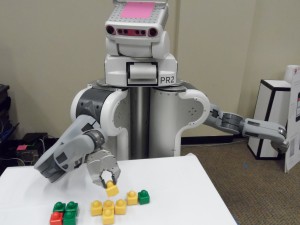 UW News reports on work by CSE faculty members Maya Cakmak and Raj Rao and their students.
UW News reports on work by CSE faculty members Maya Cakmak and Raj Rao and their students.
“University of Washington computer scientists have shown that crowdsourcing can be a quick and effective way to teach a robot how to complete tasks …
“The team designed a study that taps into the online crowdsourcing community to teach a robot a model-building task. To begin, study participants built a simple model – a car, tree, turtle and snake, among others – out of colored Lego blocks. Then, they asked the robot to build a similar object. But based on the few examples provided by the participants, the robot was unable to build complete models.
“To gather more input about building the objects, the robots turned to the crowd. They hired people on Amazon Mechanical Turk, a crowdsourcing site, to build similar models of a car, tree, turtle, snake and others. From more than 100 crowd-generated models of each shape, the robot searched for the best models to build based on difficulty to construct, similarity to the original and the online community’s ratings of the models.
“The robot then built the best models of each participant’s shape …
“The UW team is now looking at using crowdsourcing and community-sourcing to teach robots more complex tasks such as finding and fetching items in a multi-floor building. The researchers envision a future in which our personal robots will engage increasingly with humans online, learning new skills and tasks to better assist us in everyday life.”
Read more (and watch videos) here.
Science 2.0‘s version of the story, “Crowdsourcing Will Teach Robots To Become Our Future Overlords Faster,” here.

